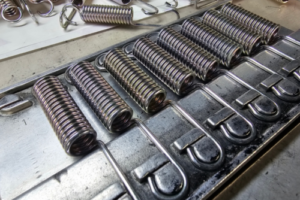Spring manufacturing is an important part of your project as it can impact the functionality and longevity of your end-product. Beyond specifying length and diameter, there are more details to consider when ordering a spring and these can influence the finished product. In this article, we take a look at the various spring manufacturing processes, exploring how they can affect performance, durability and precision in your application.

SPRING MANUFACTURING FORMATION
In essence, spring manufacturing begins by winding wire around a shaft or mandrel to create the coiled shape that is fundamental to any spring design. Most often this is achieved via automated equipment using computer numerical control (CNC) technology. Once the wire is fed into the machine, most springs are formed by either coiling, forming, or bending the wire into shape.
Advanced CNC coiling machines deliver quality, accuracy and efficiency to manufacture springs with a tight tolerance. Coiling can be undertaken with either cold or heated wire, with hot winding often used for thicker wire to increase flexibility. Tension and rotation control the wire winding process, ensuring precision and uniformity.
More adaptable than a coiling machine, a wire forming machine uses tooling to create bends and hoops in addition to standard coil shapes. These machines utilize bending, cutting, and coiling, to produce a diverse range of spring shapes and sizes.
Wire bending machines work by feeding wire into a series of rollers to guide wire to a movable tooling head which is controlled by computer. This is used to manipulate the wire into a desired form, or even a bespoke spring design.
Expert Application: Medical Wire Coiling
Some products such as medical multi-filar coils require specific expertise or equipment. The machines used to create these tiny products accurately wind filaments around a spinning mandrel to create micro-coils with multiple filars potentially with different tensions on each filar. Manufactured to tight tolerances, sometimes in clean room conditions, multi-filar coils can be used in medical device applications such as neurovascular and cardiovascular catheters.
HEAT TREATMENT
Once the spring has been formed, it typically needs to go through a heat treatment process to alleviate the stress caused by coiling. This enhances the spring’s mechanical properties by altering its crystalline structure. Depending on the metal alloy used, springs will be repeatedly heated to a specific temperature, for a set duration, and cooled either naturally or artificially. Benefits of this extended process include greater durability, increased temperature resistance, and improved ductility.
The initial step in any heat treatment process is to heat the spring above a set temperature, which is specific to the alloy in question. Very few metals are subjected to heating alone and most will undergo additional treatments to change their characteristics.
Quenching for example involves rapidly cooling the heated spring by submerging it in water or oil. This rapid cooling alters the metal’s crystal structure, transforming it into a harder and more brittle state for increased strength.
Tempering relieves any stress caused by the heating and cooling process by reheating the cooled metal spring, this time to a relatively low temperature. It works by altering the metal’s crystalline microstructure to improve mechanical properties and is often followed by annealing, which can make the metal more ductile and reduce the risk of fractures.
Application Example: Aerospace Spring Designs
Heat treatment and mechanical testing are an integral part of producing mechanical springs destined for use in the aviation or aerospace sector. To achieve the high level of processing accuracy required for this exacting sector, springs are often batch heat treated, rather than using a conveyor oven. In many cases, products require multi-stage heat treatments, often within hours of being coiled. Subsequent testing to industry standards helps to ensure parts can withstand harsh conditions in military, commercial and aviation applications.
FINISHING
The final stage in any spring manufacturing process is finishing. This might involve coating, plating or treating the surface of the spring to help prevent corrosion, extend longevity, or simply change the spring’s appearance.
One common finishing process for springs is shot peening. During this process, spherical pellets are fired at the spring in order to produce small indentations on the surface of the metal. These compressive stresses counteract tensile stresses and enhance the material’s resistance to fatigue failure.
Another finishing option is plating, whereby a thin layer of metal is deposited onto the surface of the spring during an electroplating process. This additional layer can improve corrosion resistance and strength, as well as delivering electrical conductivity for electronic applications.
Also designed to reduce corrosion, powder coating can help to prevent rust from forming on a spring’s surface. Coatings come in a range of colours and materials and can deliver many hundreds of hours of salt spray resistance.
Application Example: Industrial Springs
Springs used in heavy machinery, machinery tools, and industrial equipment can be subject to harsh conditions including extreme temperatures, abrasive particles, and corrosive substances. Coating springs provides a protective barrier against these elements as well as delivering low-friction properties to reduce wear between the spring’s coils. Common metals used for electroplating include zinc, nickel and chromium with the choice of metal depending on specific application requirements and the desired properties of the spring.
CUSTOM SPRING MANUFACTURE
From choosing the right material to selecting appropriate finishing techniques, bespoke spring design can help you specify a spring component that is precise, efficient and fit for purpose.
Working with a specialist spring manufacturer, such as SCS, allows you to tailor not just the length and diameter of your spring, but also the force, movement, tension, coatings and colour. Custom spring manufacture thereby ensures precise specifications, optimal performance, and tailored solutions designed to meet the specific needs of your application – whether that’s micro medical coils or rugged springs for earth moving equipment.
For advice on how to improve the performance and functionality of your next project, contact the expert engineering team at SCS.


